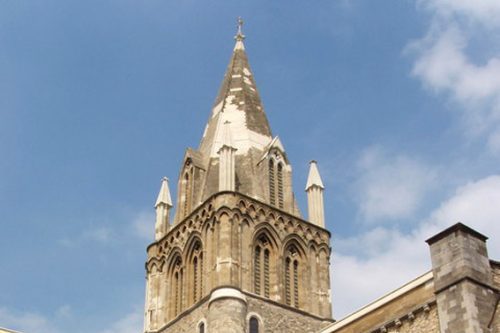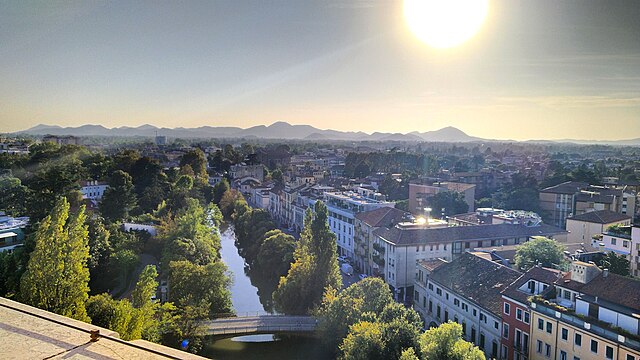Oxford’s architectural styles through time
Oxford has many architectural wonders. These world-famous buildings range from medieval towers to modern university sites, showcasing changing styles from Classical to Modern. In this blog I focus on a selection of buildings to give an insight into the multitude of architectural styles in the city.
Twelfth century: Christ Church Cathedral
Victorian poet Matthew Arnold, in his poem ‘Thyrsis’ described Oxford as ‘the city of dreaming spires’. Christ Church Cathedral, with its distinctive tower, exemplifies this idea. The spire has a pyramidal shape accented by four gabled, lucarne (dormer) windows and pinnacles at each corner of the square base. It follows the architectural style of the Romanesque and Gothic, the most characteristic styles associated with Oxford university.
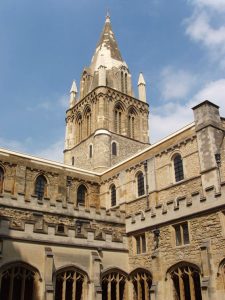
Christ Church Cathedral from the cloisters. Photo by David Hawgood
On the exterior are layers of blind arcading with rounded and pointed arches, typical of Romanesque and Gothic architecture respectively, as well as crenellated walls and buttressing. A large rose window divided into ten parts dominates the wall behind the altar and, along with the masses of stained glass windows, allows beautiful, saturated light into the cathedral. The interior feels immensely grand with large pier supports that allow the building to rise to great heights, joining at the top in the form of an intricate lierne vault.
The cathedral we see today is a small part of the original building from the twelfth century. It is what remained when a reformed Tom quad was built between 1525 and 1529, and the cathedral was absorbed into Henry VIII’s new Christ Church College. The nave, choir, main tower and transepts are late Norman, though gothic features are present. and The rich lierne vault was added in the 1500s, designed by William Orchard with a dozen pendants linked by ribs that together form eight-pointed star shapes.
Seventeenth century: Sheldonian Theatre
The Sheldonian Theatre is Oxford’s first Classical building, designed by Christopher Wren in 1664–67. Wren’s design is thought to be have been influenced by the theatre of Marcellus, illustrated by Sebastiano Serlio in Architettura, which was the largest and most important theatre in Rome. The building is modelled off the traditional D-shape of a Roman theatre but there is no built-in stage. The main entrance (not currently in use) is also placed at the flat end of the building, facing away from the busy street and towards the Divinity School. Upon entering by this door, you face the audience seating rather than a stage. The Neoclassical style of the building can be seen in its exterior symmetry and balance, formed by geometric fenestration and arches. Surrounded by a ring of 13 herms, the building is topped by an eight-sided cupola (accessible via an interior staircase) that provides views across central Oxford. Wren utilised large trusses to support the roof and the cupola without building columns that would have interrupted the expanse of the ceiling.
The Sheldonian Theatre was thought to have the widest unsupported floor in the world for many years. The roof is also beautifully decorated by painter Robert Streater. His painting represents an allegory of the Triumph of Religion and Learning after the Civil War with a view of the sky that reflects the traditional open-sky design of Roman theatres.
Nineteenth century: Oxford Town Hall
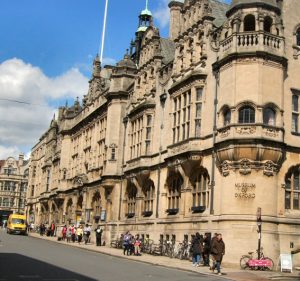
Oxford Town Hall and Museum. Photo by Paul Gillett.
Oxford City Council describes the Town Hall (home of the Museum of Oxford) as ‘a wonderful example of late Victorian civic pride’. It was designed in a Neo-Jacobean style (Jacobean is named after seventeenth-century King James I of England), by Henry T Hare. Hare’s design was selected from move than 300 competition entries in 1892. The undulating roofline has gables and cupolas, Tudor arches frame windows on the lower floor, and windows project outwards with gentle organic supports, decorated by intricate carving.
Over time, through Romanesque to Gothic, Neoclassical and then Victorian, more more whimsical elements were included in the facades of buildings. This can be seen clearly in the windows. A variety of short, tall, rectangular and rounded windows is used on the Town Hall, although in an organised manner, to ensure the building does not appear too eclectic. In addition the surface of the building forms continuous curves, instead of the flat, imposing mass of earlier buildings. The interior contains a beautiful domed ceiling, balconies, an organ and a stage that allows the space to be used for a multitude of occasions, whiel retaining its grandeur. There are smaller rooms that showcase typical Victorian timberwork.
Twenty-first century: Biochemistry building
Architectural styles continue to evolve in the city. The Saïd Business School, designed by Dixon Jones architects and built in 2002, adds a ziggurat tower to the skyline and has a glass curtain wall that contrasts dramatically with the brown stone used for most of the nearby buildings it surrounds.
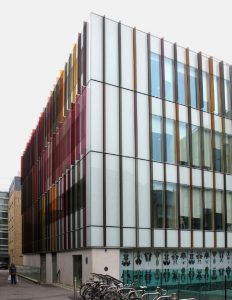
The Department of Biochemistry building. Photo by David Hawgood.
The Department of Biochemistry building (2008) designed by Hawkins/Brown also has a glass curtain wall that stands out against Oxford’s historic buildings. Colourful glasswork protrudes from the building’s flat surface, reflecting an ambitious arts programme linked to the scientific process of discovery.
Oxford has many other great works of architecture, including the Radcliffe Camera, and both the new and old Ashmolean buildings. Look around during your next visit to the city and indulge in the wonderful mix of classic and modern that is Oxford.
Written by volunteer Alina Hu.
Want to write your own Oxford-inspired post? Sign up as a volunteer blogger.
Photo of Sheldonian Theatre © Prosthetic Head/Wikimedia Commons, https://creativecommons.org/licenses/by-sa/4.0/deed.en
Photos by David Hawgood and Paul Gillett © the photographers cc-by-sa/2.0

